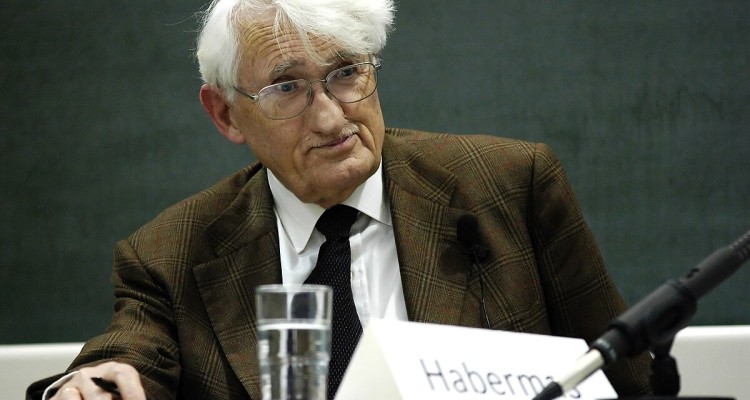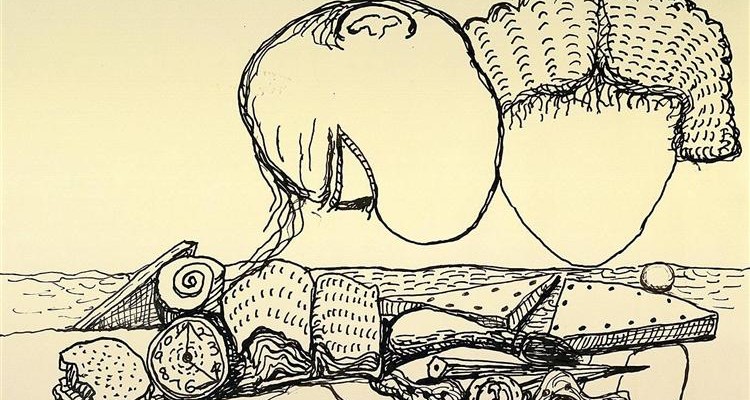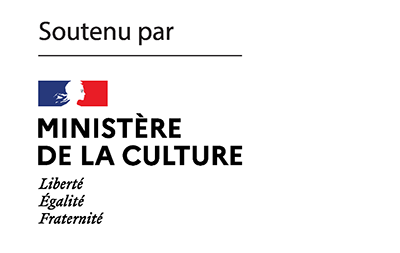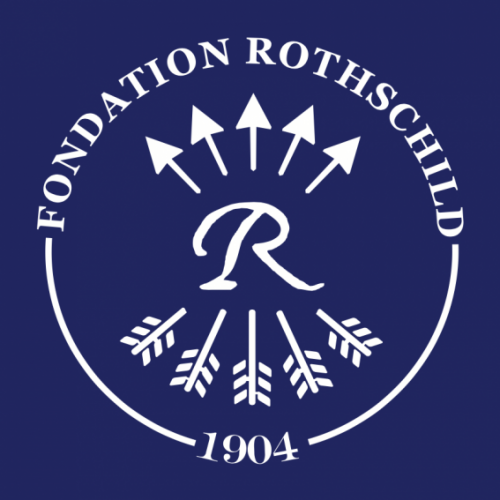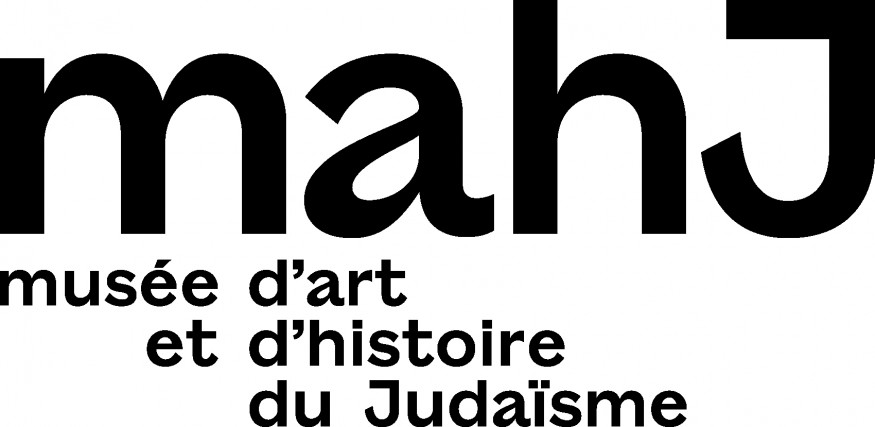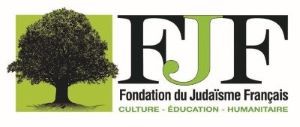(Notes from the Field)
A group of students enrolled in a course on the Polish Righteous Among Nations went to Markowa, in the Lower Carpathians, to visit the “Museum of Poles Saving Jews during the Second World War – Ulma Family.” Ewa Tartakowsky, as part of her research on the transmission of the Jewish past in Poland since 1989, followed this visit. She explains how the discourse that accompanies it resonates with the memorial policies promoted by the PiS government. Excerpts from a field diary, part one.
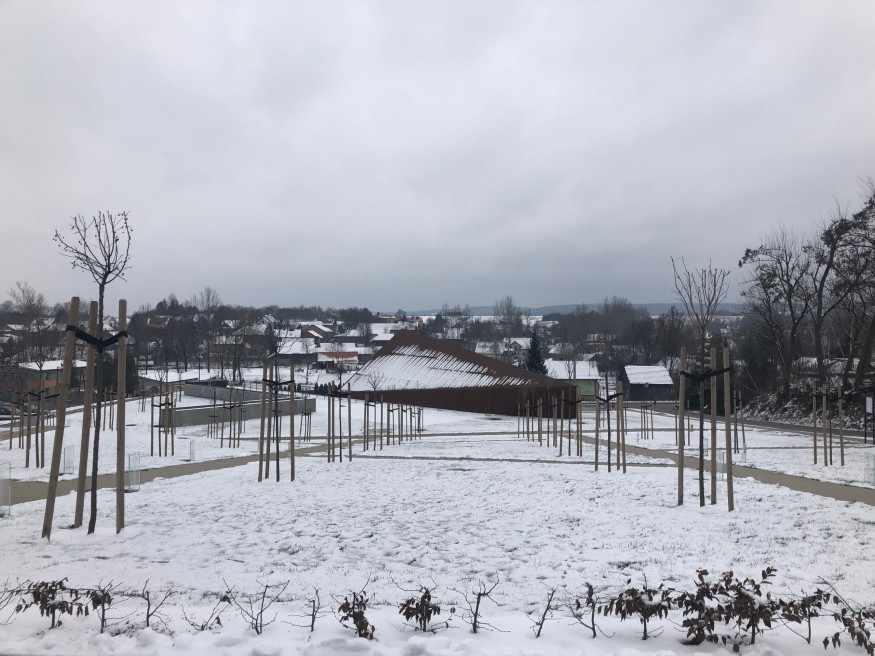
We are finally in Markowa ! Here, in the Subcarpathian region, it is less than two degrees Celsius and, after a two and a half hour drive from Krakow, it feels as if it were minus ten. Students and adults alike, we all get out of the bus, delighted to stretch our legs. The trip has put us in a kind of frozen bubble: adults in the front, students in the back, following a well-known hierarchy of the school world. I move around to chat with the teachers and capture the informal conversations of the young people: school, homework, friends, life and its daily routine… The “Righteous Among Nations” can wait until we start the day’s visit: that of the “Museum of the Poles Saving Jews during the Second World War – Ulma Family,” [1] preceded or followed (depending on the group) by a discussion workshop.
Around us, a few buildings emerge vaguely from a horizon of fields stretching as far as the eye can see. Here and there, the tufts of grass that survived an old harvest stand out, gray-brown reflections on a snowy background. After getting into shape, the students gather. They come from middle and high schools in Białystok, Zielonka, Świdnik, Radom, Wrocław, Chojnów, Szydłowiec, Kalisz, Gołcza, and Warsaw and participate in an educational program about the Righteous Among the Nations, organized by the Center for Holocaust Studies at Jagiellonian University. Each group – four, five students per school – is accompanied by teachers, most of whom are women. They were the ones who introduced the program to the students and encouraged their participation. Two university educators from Kraków are also with us, and among the teachers I find Jolanta, a Polish teacher in Świdnik with whom I spent about ten days in 2018, in Warsaw and Jerusalem, as part of another training course dedicated, she, to teaching about the Shoah, and Zosia, who teaches history in Białystok and whom I crossed paths with at the training course for Polish teachers at the Holocaust Memorial a year earlier.
A Museum with Political Overtones
The Museum we are about to visit is dedicated to the Ulma family – Józef and Wiktoria and their six children, seven counting, as the Markowa monument does, one with whom Wiktoria was pregnant. All of them were murdered by the Nazis for having given refuge to the Szall and Goldman families. Józef and Wiktoria Ulma were awarded the Righteous Among the Nations Medal by the Yad Vashem Institute in Israel postmortem in 1995, and in 2010 President Lech Kaczyński also awarded them the Commander’s Cross of the Order Polonia Restituta. On March 17, 2016, the current President Andrzej Duda inaugurated the museum, the first one devoted entirely to non-Jewish Poles who saved Jews during the war, and a beatification process for the Ulma parents is currently underway.
The inauguration was a real media and political event. The president’s presence in this village of 4,000 people illustrates and exalts the turn in historical politics in Poland since 2015, with the Law and Justice (Prawo i Sprawiedliwość, PiS) party coming to power. Andrzej Duda shares what Jarosław Kaczyński, president of PiS, refers to as the need to “straighten up” [2] in order to break with what is now perceived as a “pedagogy of shame.” This would be associated with the so-called critical history, the one that incorporates the “non-glorious” past of Polish society. In 2017, Andrzej Duda clarified his opinion on the period of the liberal governments of the Civic Platform (Platforma obywatelska, PO): “All the time: shame, shame, Poles are this, are that… I apologize, but we have something to be proud of and we should be proud. It is the others who have something to be ashamed of, not us [3].
My visit to the Markowa Museum [4] is part of this context, which raises a series of questions: how do students understand current historical policies, how do they identify and interpret them? What do they make of the past of Polish Catholics, of Polish Jews during the Second World War?
The history of the Shoah takes a singular place here: it crystallizes the old discussions about the position of non-Jewish Poles in the genocide of Polish Jews. Since the 2000s, Jan Gross’s work on the crime of Jedwabne has catalyzed the Polish public debate on this issue [5]. It concerns the massacre of the Jewish population of a town in northeastern Poland by their non-Jewish Polish neighbors in the summer of 1941, in the context of the withdrawal of the Soviet troops occupying the region in the face of the German offensive. Gross’s publications on the responsibility of non-Jewish Poles in anti-Semitic pogroms before, during and after the Second World War have already reshaped the landscape of knowledge on these subjects and stimulated new research. They also made it possible, in 2008, for the history curriculum to include not the theme of the “Righteous” or “aid to the Jews” but that of “the attitudes of Polish society towards the Holocaust,” a formulation that allows for a diversity of attitudes in Polish society toward the genocide.
In contrast to the “pedagogy of shame,” the historical policy of the PiS since 2015 is committed to “presenting the Polish point of view”, in other words, fighting against everything that is deemed likely to “tarnish the honor of the nation” and to “falsify” the history of Polish heroism. The Institute of National Remembrance’s (IPN) educational website “Truth about death camps ,” whose aim is to “remind the world that the sole responsibility for the creation of the ‘death factories’ lies with the German state,” is a case in point; the John Paul II Museum “Memory and Identity,” created in 2018 by the Ministry of Culture and National Heritage and the Lux Veritatis Foundation[6], currently under construction, which will present, among other things, the history of Polish Catholics saving Jews during the Second World War. This museum facility will be linked, on the one hand, to the Chapel of Memory, already existing in Toruń, which commemorates the Polish Catholics martyred for saving the Jews[7], and on the other hand to the National Memory Park where “the thousands of heroic Poles saving Jews during the Second World War” will be commemorated.
Another project, inaugurated in 2018, concerns the Warsaw Ghetto Museum, which should, according to Piotr Gliński, Deputy Prime Minister and Minister of Culture and National Heritage, “speak of the love between two nations that spent 800 years in this place, on Polish soil. It will be [a story] of solidarity, brotherhood, also of historical truth in all its aspects.” [8].At the time of the inauguration, this new institution raised many fears on the part of Polish and Israeli historians, especially since the museum’s mission, as defined on its website, mentions only the Jewish victims and the German oppressors, totally omitting the role of non-Jewish Poles in the history of this uprising, in that of the other ghettos, and more broadly, in the Holocaust [9].
Finally, the IPN’s 2018 legislative reform, the so-called “Holocaust Law,” provided for prison sentences or fines for “anyone [who] publicly and in defiance of the facts accuses the Polish nation or the Polish state, of being responsible for or complicit in the Nazi crimes committed by the German Third Reich, specified in Article 6 of the Statute of the International Military Tribunal, or other crimes against peace and humanity, or war crimes, or otherwise grossly diminishes the responsibility of the actual perpetrators of these crimes.” The articles in question were eventually repealed under international pressure. However, history remains under legal scrutiny. The lawsuit against two historians from the Center for Holocaust Studies of the Polish Academy of Sciences, Jan Grabowski and Barbara Engelking, the editors of the book Dalej jest noc, is a concrete illustration of the current historical policy. The report on the activity of the Institute of National Memory for 2018 also attests to this: “The mission of the Polish state is to safeguard memory and national dignity, formed on the basis of the past. The Polish state cannot accept the phenomenon of anti-polonism, which demeans national dignity and memory”.
In this perspective, the Polish Righteous are an important collective figure to prove the innocence of Polish society during the Second World War. Present in museographic or commemorative devices, they have been granted since 2017 an unprecedented place in the new school history curriculum, which closes the space opened by the aforementioned 2008 curriculum. Historian and PiS senator Jan Żaryn, active in the Committee for the Remembrance of Poles who Rescued Jews, says in this regard: “In all textbooks concerning Holocaust education, paragraphs should present information about the exceptionality of Poland, the Polish government in exile, the Polish underground state, but also about those Poles who under the German occupation fulfilled their Polish mission and helped the Jews during World War II.“ The place of the “Righteous” has, in fact, become central to the narrative of the Second World War in Poland, to the point that researcher Justyna Kowalska-Leder speaks of the “omnipresence of the Righteous.” [10]
The Markowa Museum is fully in line with this trend, which articulates domestic historical policy, including that for schools, with historical diplomacy. On the eve of its inauguration, the Polish Parliament hoped that the Museum would “inspire central and local authorities to commemorate in the future the acts committed by Poles saving Jews and to promote this knowledge even beyond Poland’s borders. This is all the more necessary because the world does not know the reality of Polish lands during the tragic years of the 1939-1945 war and the historical ignorance, which we face abroad, offends the honor of the homeland.”
Before the Visit, Anna Prepares Us…
Here we are. Described as the “glory of Markowa,” the “glory of the Subcarpathian region,” and even as a “symbol of Polish sacrifice,” the museum appears on the horizon as a low, triangular mass, designed by the architectural firm Nizio Design International. To get there, we have to cross the “park of memory,” whose clearly visible paths form a strict geometry between the white lawns and the newly planted young trees.
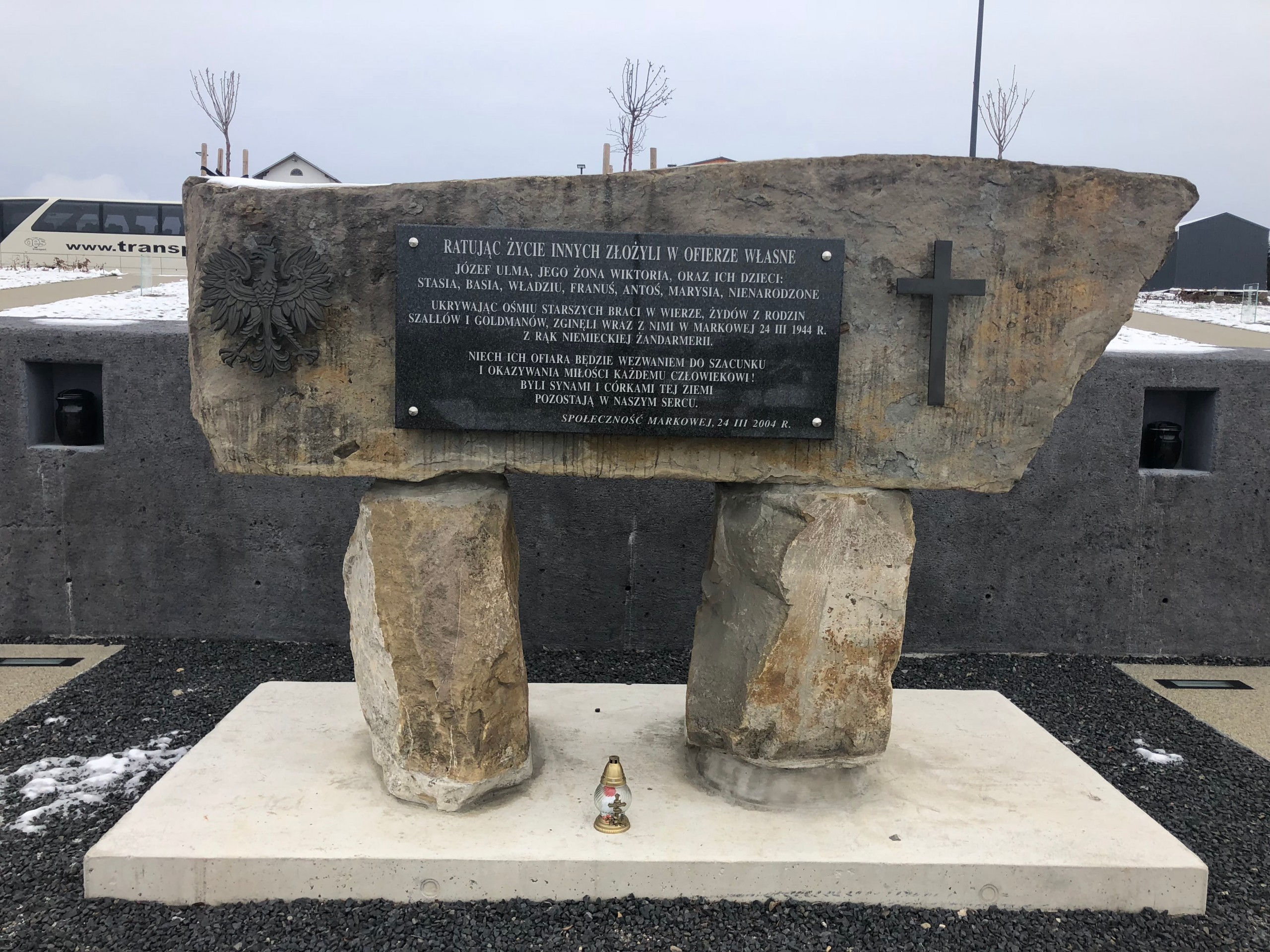
We pass a cenotaph topped by an eagle – the emblem of Poland – and a cross, as well as a plaque engraved: “May their sacrifice remind us to respect and love every human being!” Christian sacrifice will, we will see, be a common thread of this visit. For the moment, we are waiting in front of the building. On the side of the “park of memory,” it buries itself in the slope of the ground, blending into it, like a rusty wreck. The façade, also rusty, has the archetypal shape of a house. A long concrete wall at the right corner of the entrance is decorated with the names of the Polish Righteous Among the Nations from the Subcarpathian region. In front of it, three Polish flags flap in the wind and a large photograph of the Ulma family, the same one featured in some history textbooks, faces the visitors, sheltered behind a huge picture window. To the left of the entrance, a plaque, also rusty, has become illegible…
While we wait for the time in the ballroom, located a few steps from the Museum, Anna [11], one of the facilitators of the Jagiellonian University program, prepares the students for the visit and tries to get them to think about the different memorial devices present on site: “Who tells the story of the Ulma? We must ask ourselves what need this museum serves. We will also learn from the guide when this museum was created, why the Day of the Righteous was established and why President Duda came here.” [12] So everything is laid out in the background: the issues of historical projects, the historical policy of PiS.
– “What do you expect to see in this museum?”, asks Anna.
– “…old, yellowed documents, torn, damaged photos,” answer students.
– “How can these objects be displayed?”
– “In a display case,” replies a girl. Other voices indicate: “framed,” “in albums,” “as a presentation [understood as a digital slide show],” “as a film.”
– “What will be our reception depending on the medium?” continues Anna.
– “Photos in display cases are boring,” says one voice. “A presentation is much better because the pictures change, but it’s not a good form because you can’t think, because the pictures change,” a student comments contradictorily.
– “So, depending on the effect we want to cause, we choose different media,” concludes the facilitator, who continues, “What comes out of it?”
– “In terms of the presentation, it’s that… everything is out of our hands, but it’s also dynamic,” the same student replies.
– “And what else can you see in a museum?”, Anna continues.
– “Tools. To see how we used to live,” risks a student, shyly.
– “And what is that for?”
– “To show the truth,” the student replies.
– “And why do we think it’s the truth?” questions Anna while flashing me a smile.
– “Because it is the archives that show it,” says a girl.
– “So we know because they are public institutions. Do you know what these institutions are?”
– “That [sic!] anyone can learn history there,” we hear.
– “That is, everyone can learn their history in a museum?”
– “No!” one student objects, “because they have to be important people!”
– “And who decides that?” Anna reaches the end of her reasoning. Silence…
– “And here we have a problem,” breaks in a teacher.
It is time to leave the ballroom; as a conclusion, Anna introduces the following: “This project refers to the Righteous. But you will also find other notions: mercy, sacrifice. Pay attention: do you see references to justice, because after all that is the notion to which the museum refers, or to mercy, to sacrifice? What could it mean? You can ask the guide any question you like about what we have already seen together.”
Evocation of an (almost) wonderful past
After finding the wall that pays tribute to the “Poles who saved the Jews in the region of the Lower Carpathians,” we enter, passing by a mezuzah, which I am the only one, I think, to notice. I was de facto the only one to stop and take a picture of it. Perhaps this is because no one has pointed it out to visitors. At the entrance, a sign warns curtly: “External guides are not allowed to guide through the exhibition”; next to it, a display of books is next to a reception desk.

At the head of the display is the book In Praise of the Merciful. The Ulma Family, whose cover advertisement reads “A poignant story of a Polish family who sacrificed their lives to save the Jews.” The book, published by the Catholic publishing house Rafael, is by Mateusz Szpytma, former director of the Museum and current deputy director of the IPN, and Jarosław Szarek, director of the IPN since 2016. The book opens with an introduction by Józef Michalik, Archbishop of Przemyśl, President of the Polish Episcopate: “Markowa is a village like so many others in the Archdiocese of Przemyśl and in Poland, and Józef and Wiktoria Ulma’s family of God’s servants [słudzy Boży] resembled the others of their time.” With this simple introductory sentence, the entire complexity of wartime situations is erased: the complexity that Jacek Leociak of the Center for Holocaust Studies, in particular, speaks of when he discusses the double discourse on the rescue of the Jews. On the one hand, “a narrative about heroism, sacrifice, altruism,” on the other hand, “about the fear of being betrayed by one’s neighbors, about blackmail, about meanness.”[13] But the Archbishop proposes a political project that is clear and very contemporary: “The discovery and love of the family vocation are also important today. Love for the unborn child [Wiktoria was pregnant at the time of her murder], love for paternal effort and motherhood are the foundation of the health of humanity, a condition for human development and hope for social balance. When the sensitivity for the child dies, dies also the will of sacrifice, develops selfishness, and from there, a step is enough to the hatred that bruises human relations.” Published in 2018, the statement can only be read in light of the current debates around the total ban on abortion, women’s rights and LGBT+ rights.
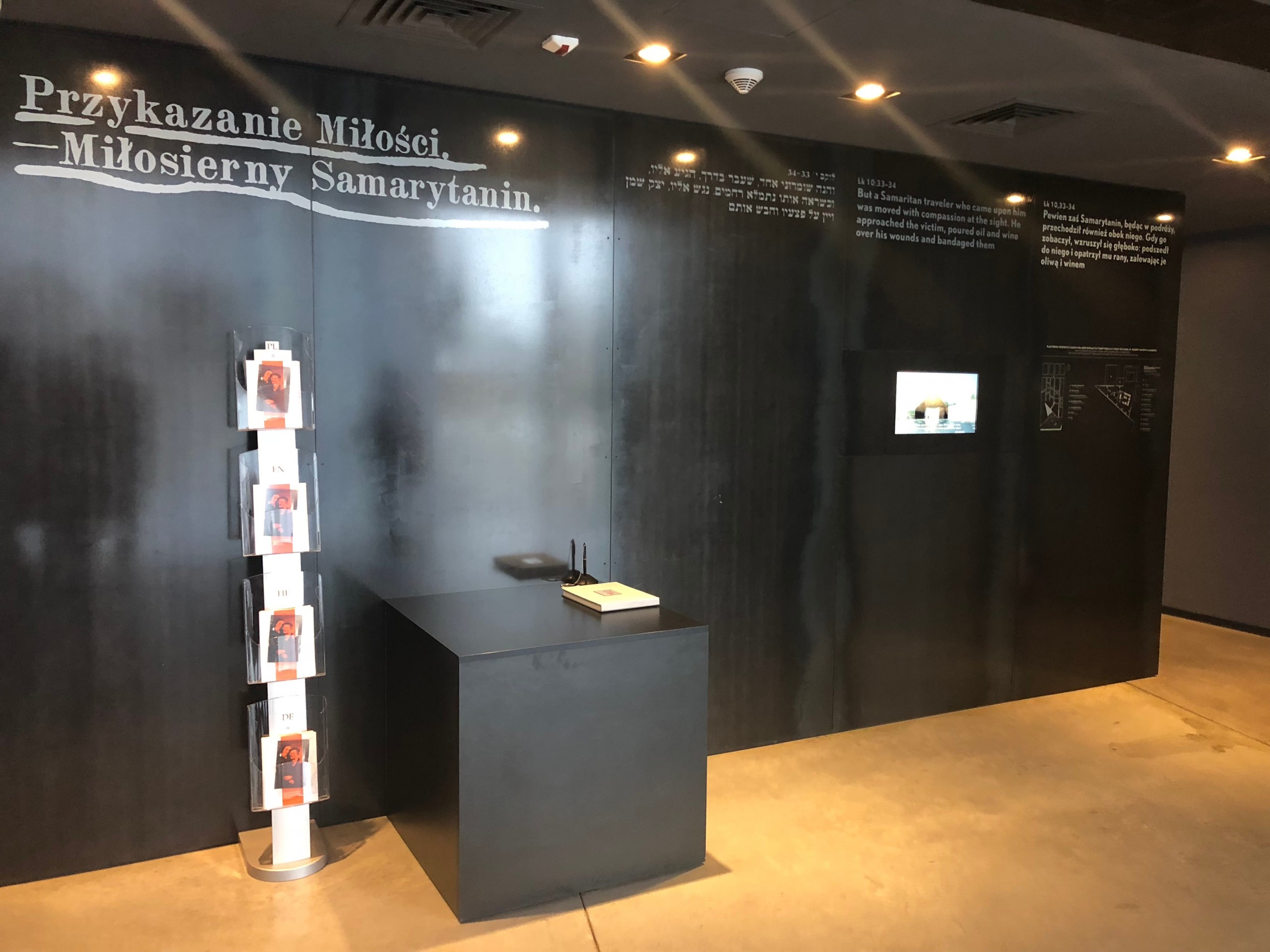
Like the students, their teachers and Anna, I wander around waiting for the guide. Anna shows me a sign that reads, written in large capitals: “Commandment of love: the merciful Samaritan,” followed by a quote: “But a Samaritan, who was traveling, having come there, was moved with compassion when he saw him. And he came to him and bandaged his wounds, pouring oil and wine on them; and he put him on his own horse and brought him to a guesthouse and took care of him (Luke 10:33-34).” Created in 2016, the mobile exhibition “Samaritans of Markowa. The Ulma – Poles Killed by the Germans for Helping the Jews” was already constructed on a Christian semantic field, as was the title and content of the film Our Daily Bread (Chleba naszego powszedniego) that accompanied it. Under the panel with the gospel quotation, I see a display case with Museum leaflets and a guest book. I leaf through it, keeping in mind the difficulty of interpreting this type of source. Very quickly, however, I decide to use my phone to take some photographs, so significant does the homogeneity of the messages seem to me: “Never again” dated August 8, 2018, “A Niepokalanów pilgrimage of St. Maximilian Kolbe [14]” on the same date; the next day, registrations of a group of retired teachers and education workers, participants of another pilgrimage with the wish for a quick beatification of the Ulma family; a priest’s message on the day of St. Mary of the Fields (Matka Boska Siewna), August 28, 2018; greetings from a group that came from the shrine of St. Mary of Perpetual Help (Matka Boska Wspomożenia Wiernych) in Oświęcim, the city where the Auschwitz-Birkenau camp is located. Other messages left by groups led by religious people dot the pages. During their visit, Jan Grabowski and Dariusz Libionka had already noted the presence of small images with, on the front, a reproduction of the Ulma family, “servants of God,” on the back, a prayer for their canonization [15].
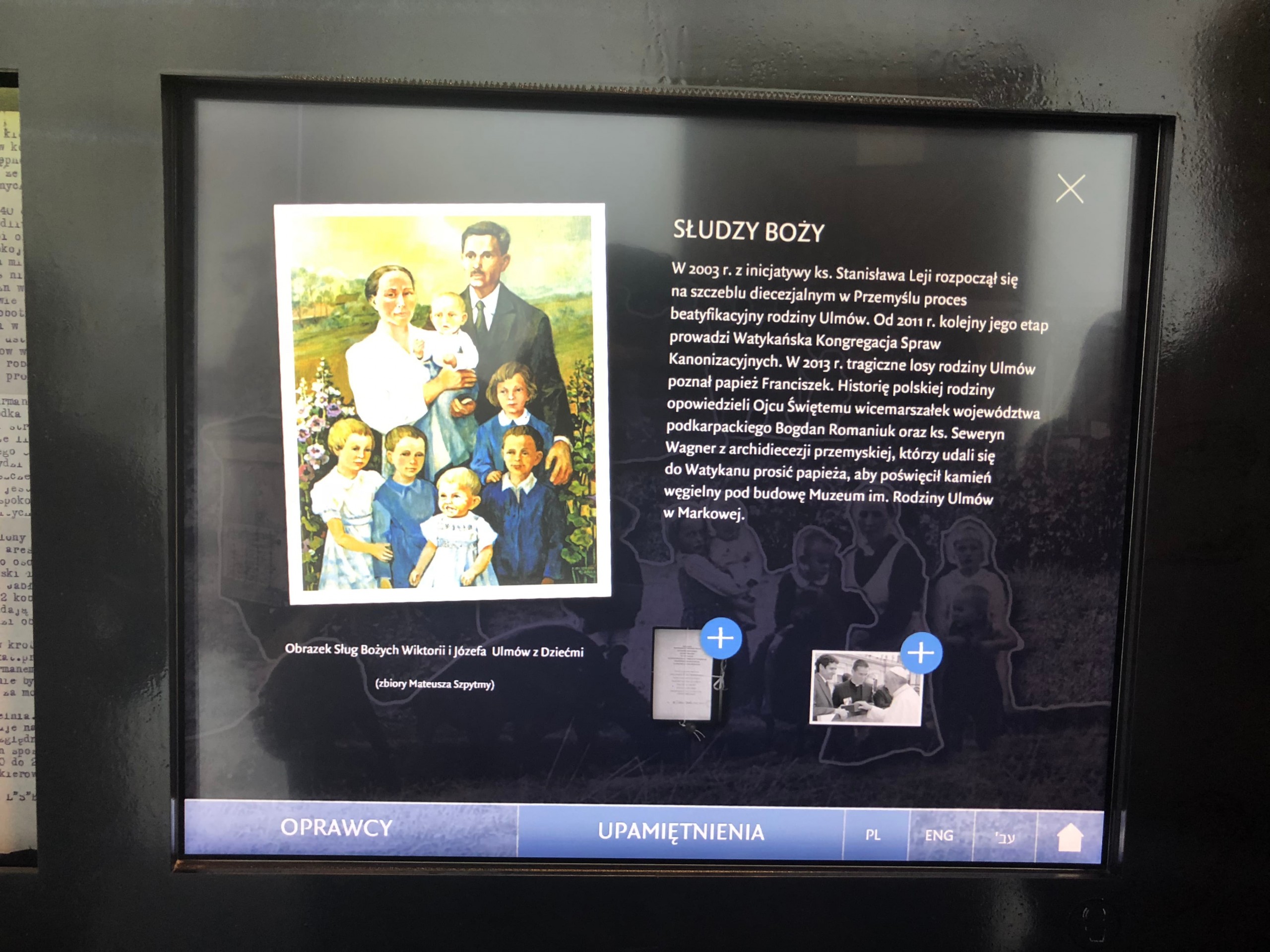
Our guide arrives. He is in his late thirties, with a good-natured look, wearing a red shirt with large black checks and bifocals. His first words mark a distance with an audience that he considers a priori acquired to a critical vision: “I am already afraid, because you are from the Jagiellonian University, even from the Center for Holocaust Studies. There will probably be some controversial questions and I don’t know if I will be able to answer.” Anna winks at me. I’ve only been with her for two days, but the connection was immediate. The contact was made easier by the fact that her father was one of my Yiddish teachers when I was still living in Poland. A few words were enough for me to understand that the training for students and teachers – entitled “Righteous Among the Nations as a Timeless Example” – does not fit into the line promoted by the current government. The weekends during which the participants train are devoted to dissecting the making of cultural and historical policies and projects in general and to developing project management skills in particular. This is their third meeting on this theme. I am therefore looking forward to observing how the students will appropriate this high-potential political visit experience…
Next week, the second and final part
Ewa Tartakowsky
Ewa Tartakowsky holds a doctorate in sociology. Her work focuses on the public use of the past as well as on collective representations related to Jewishness. She is notably the author of Les Juifs et le Maghreb. Fonctions sociales d’une littérature d’exil (PUFR, 2016) and co-edited Jewish Europe Today: Between Memory and Everyday Life (Austeria, 2020).
Notes
| 1 | The full name in Polish: Muzeum Polaków Ratujących Żydów podczas II wojny światowej im. Rodziny Ulmów. It will be called hereafter ‘Museum’. |
| 2 | The Polish expression wstawać z kolan literally means “to rise from the knees”, with a religious connotation. |
| 3 | Prezydent.pl, 30.04.2017 |
| 4 | These are ethnographic observations, made as part of my postdoctoral project on the school transmission of the Jewish past in Poland, supported by La Fondation pour la Mémoire de la Shoah and the Memorial Foundation for Jewish Culture. |
| 5 | Jan Gross, Neighbors: The Destruction of the Jewish Community in Jedwabne, Poland. Princeton, NJ: Princeton University Press, 2001. |
| 6 | Lux Veritatis is a Catholic foundation, created by the priest Tadeusz Rydzyk in 1998. This priest represents the ultra-conservative current of the Polish Catholic Church and is known for defending creationist, nationalist, anti-Semitic and homophobic theses. The Foundation is part of an already existing media-educational conglomerate, headed by Father Rydzyk, consisting of the Maryja radio station, the Trwam television channel and the High School of Social and Media Culture located in Toruń. |
| 7 | Chapel of the memory [Kaplica Pamięci]. |
| 8 | Ministry of Culture and National Heritage, « Minister kultury Piotr Gliński utworzył Muzeum Getta Warszawskiego », 2019. |
| 9 | Warsaw Ghetto Museum. |
| 10 | Justyna Kowalska-Leder, « Wszechobecność Sprawiedliwych », Zagłada Żydów. Studia i Materiały, 2014, n°10, p. 1073-1083. |
| 11 | All names have been changed. |
| 12 | All quotes are drawn from the author’s ethnographic observations. |
| 13 | Jacek Leociak, Ratowanie. Opowieści Polaków i Żydów, Cracovie, Wydawnictwo Literackie, 2010, p. 13. |
| 14 | The priest Maksymilian Maria Kolbe was executed by the Nazis in the Auschwitz camp in 1941, after having offered to die in place of another prisoner. Canonized in 1982 by John Paul II, Maksymilian Kolbe is literally revered within the Catholic Church, without ever mentioning his pre-World War II anti-Semitism, evidenced, among other things, by his writings in the newspapers The Knight of the Immaculate (Rycerz Nipokalanej) and The Little Diary (Mały Dziennik). In 2017, Maksymilian Kolbe was mentioned for the first time in the curriculum of the senior high school history under the heading of “postures of Polish society towards the occupier […] and examples of heroism of Poles,” and therefore in all authorized textbooks. Neither the curriculum nor the textbooks mention his anti-Semitism. |
| 15 | Jan Grabowski et Dariusz Libionka, « Bezdroża polityki historycznej. Wokół Markowej czyli o czym nie mówi Muzeum Polaków Ratujących Żydów podczas II Wojny Światowej im. Rodziny Ulmów », Zagłada Żydów. Studia i materiały, n°12, 2016, p. 621. |
